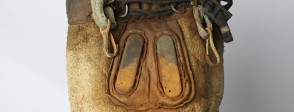Ask students to use the gas mask as a source of evidence.
Begin by introducing the gas mask as a mystery object. Give students an image of the gas mask and tell them its dimensions, without telling them what it is. Ask them to look at it carefully - drawing can be an effective way of observing an object, so you may wish to ask them to make a sketch. Ask students to discuss everything that they can observe - shape, materials and parts - and use this information to try to guess what it was used for. Compare the masks from the Science Museum and the Australian War Memorial in For the classroom.
Ask students to use the objects in A Bigger Picture to check if their guesses were correct and to research how the gas mask worked. Further sources, including film, a podcast and photographs are provided in For the Classroom.
Although this is a gas mask for a horse, it can tell us about the human experience of war. Ask students to list all the people they can think of who were connected to the gas mask, thinking about how the mask was manufactured, distributed, used, discarded and eventually acquired by the museum. Students could produce a written list or spider diagram or a role play, giving voices to those people and considering their location, gender and experiences of war. Use the resources in A bigger picture to provide detail. This also provides an opportunity to discuss war work on the home front and the role of women in manufacturing gas masks.
Ask students what the gas mask tells us about the technology available during the First World War. What does it reveal about the use of gas as a weapon and about the use of horses? By researching gas and the effectiveness of gas masks and comparing the gas mask to later horse gas masks, students can examine how prepared either side was for the use of gas as a weapon. There are useful links in A bigger picture.
Ask students to select an enquiry focus: either the use of horses and other animals during the First World War or the use of gas as a weapon during the First World War. There are links in For the classroom: the Imperial War Museum’s articles about gas warfare and animals, and their collections search provide a good starting points. Ask students to devise a system for sorting and categorising their findings. Students could research which animals were used, what they were used for and why they were used, or the different types of gas, how and why they were used. Ask students to pair up so that students who focused on animals can present their discoveries to those who focused on gas and vice versa. Students can then collaborate in their research about protection from gas; looking at different types of gas masks for humans and animals, how they worked and how effective they were.
Use the gas mask to examine chronology and change.
Ask students to prepare to debate the argument that by the First World War horses were no longer useful in war. Use the links in For the classroom to research the changing technology that made cavalry less successful at the front line and to research the uses horses were put to behind the front line. The Warhorse: Fact and Fiction and HorsePower websites provide a range of sources and information on this subject. The audio extract from War Horse may help students consider their language and presentation style. Ask students to consider what the gas mask tells us about the usefulness of horses.
Use the gas mask and links in For the classroom to examine depictions of the experience of war.
Ask students to compare the two prints and the recruitment poster in For the classroom. Ask them what impression of war each image is intended to present, what they show us about soldiers’ experiences of war, which image they think is the most accurate and why, referring to the understanding of the realities of war they have gained by researching the horse gas mask. Ask them to discuss why each image was made and why particular imagery was chosen.
If the gas mask is German, it may have been collected as a souvenir by a British soldier. Show students the photograph of the Souvenir King in For the classroom. What objects do they think are his and which are his souvenirs? Ask them to discuss why soldiers would want to collect souvenirs during a war. What would they want to remember, and why? How do we remember the war now? Is it for the same or different reasons?


